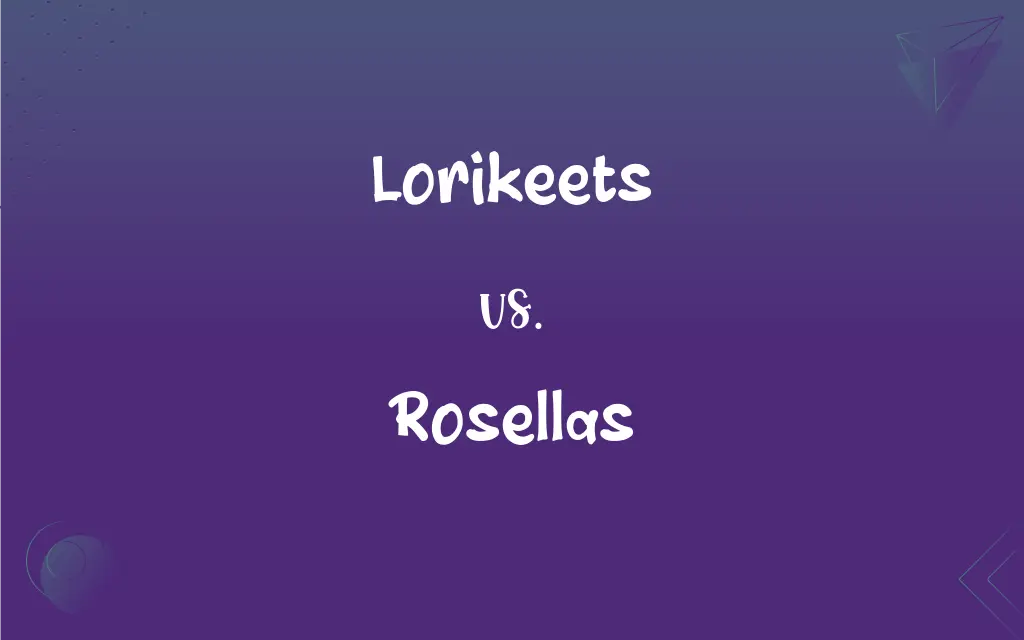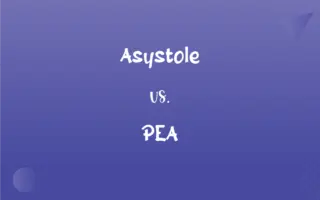Lorikeets vs. Rosellas: What's the Difference?
Edited by Aimie Carlson || By Janet White || Published on February 29, 2024
Lorikeets are colorful parrots known for their brush-tipped tongues and nectar-feeding habits. Rosellas are parrots with distinctive cheek patches and varied plumage, feeding mainly on seeds.

Key Differences
Lorikeets are specialized nectar feeders, using their unique brush-tipped tongues to extract nectar and pollen. Rosellas, in contrast, have a more varied diet, primarily consuming seeds, fruits, and insects.
Lorikeets are recognizable by their vibrant, multi-colored plumage and slender bodies. Rosellas are known for their striking cheek patches, and their plumage varies widely among species, often featuring combinations of blues, greens, and reds.
Lorikeets are commonly found in the tree canopies of rainforests, coastal bush, and woodland areas. Rosellas are more likely to inhabit forests and woodlands, as well as suburban gardens and parks.
Lorikeets are social and often seen in noisy flocks. They are playful and acrobatic in nature. Rosellas, while also social, tend to be less noisy and are often seen foraging on the ground or in trees, sometimes in pairs or small groups.
Lorikeets typically nest in tree hollows, lining their nests with chewed wood. Rosellas also prefer tree hollows for nesting but are known to adapt to various nesting boxes when in suburban environments.
ADVERTISEMENT
Comparison Chart
Diet
Specialize in nectar and pollen
Consume seeds, fruits, and insects
Physical Appearance
Vibrant, multi-colored plumage, slender bodies
Distinctive cheek patches, varied plumage
Habitat
Rainforests, coastal bush, woodlands
Forests, woodlands, suburban areas
Behavior
Social, noisy, acrobatic
Social but less noisy, forage on ground/trees
Nesting
Tree hollows with chewed wood
Tree hollows, adaptable to nesting boxes
ADVERTISEMENT
Lorikeets and Rosellas Definitions
Lorikeets
Colorful parrots known for their nectar-feeding habits.
Lorikeets were busy feeding on the flowering eucalyptus trees.
Rosellas
Parrots with distinctive cheek patches and varied plumage.
The rosellas' bright cheek patches were visible as they fed in the garden.
Lorikeets
Vibrant and social birds found in rainforests and woodlands.
A flock of lorikeets chattered loudly in the canopy.
Rosellas
Seed-eating birds often found in forests and suburban gardens.
Rosellas foraged on the ground, picking up seeds and small insects.
Lorikeets
Nests in tree hollows, often in colorful, noisy colonies.
Tree hollows in the park were home to a colony of lorikeets.
Rosellas
Adaptable to different environments, including urban areas.
Rosellas have become a common sight in suburban backyards.
Lorikeets
Parrots with brush-tipped tongues adapted for nectar extraction.
The lorikeets used their specialized tongues to sip nectar.
Rosellas
Less noisy than lorikeets, seen foraging in pairs or small groups.
A pair of rosellas quietly searched for food among the bushes.
Lorikeets
Playful and acrobatic birds often seen in noisy groups.
The lorikeets were performing aerial acrobatics near their nest.
Rosellas
Prefer tree hollows for nesting, adaptable to nesting boxes.
In the garden, the rosellas inspected a provided nesting box.
Lorikeets
Any of several small, often brilliantly colored Australasian parrots that feed primarily on soft fruits and on nectar and pollen.
Rosellas
Plural of rosella
Lorikeets
Plural of lorikeet
FAQs
What distinguishes rosellas?
Their cheek patches and varied seed-based diet.
What are lorikeets known for?
Their vibrant colors and nectar-feeding habits.
Where do lorikeets usually live?
In rainforests, coastal bush, and woodlands.
What is the typical habitat of rosellas?
Forests, woodlands, and suburban gardens.
How do lorikeets feed?
They use their brush-tipped tongues to extract nectar and pollen.
Are lorikeets social birds?
Yes, they are very social and often found in noisy flocks.
Where do lorikeets nest?
In tree hollows, using chewed wood for lining.
Are rosellas good for beginner bird owners?
They require specific care but can be suitable for experienced bird owners.
What do rosellas eat?
Mainly seeds, fruits, and insects.
What colors are common in lorikeets?
They display a range of vibrant colors like green, blue, and red.
Can lorikeets be trained?
Yes, they are intelligent and can be trained.
What is the lifespan of lorikeets?
They can live up to 20 years in captivity.
Do rosellas require special care?
Like all parrots, they need a well-balanced diet and environmental enrichment.
How do rosellas behave in the wild?
They are social but less noisy, often seen foraging on the ground or in trees.
How long do rosellas live?
They can live for around 15 years in captivity.
Do lorikeets talk or mimic sounds?
They are known for mimicking sounds to some extent.
Can lorikeets be kept as pets?
Yes, they are popular pets due to their playful nature.
Are rosellas noisy?
Less noisy compared to lorikeets, they have a softer call.
Do rosellas adapt to urban environments?
Yes, they can adapt to suburban areas and nesting boxes.
What colors do rosellas typically have?
They have varied plumage, often including blues, greens, and reds.
About Author
Written by
Janet WhiteJanet White has been an esteemed writer and blogger for Difference Wiki. Holding a Master's degree in Science and Medical Journalism from the prestigious Boston University, she has consistently demonstrated her expertise and passion for her field. When she's not immersed in her work, Janet relishes her time exercising, delving into a good book, and cherishing moments with friends and family.
Edited by
Aimie CarlsonAimie Carlson, holding a master's degree in English literature, is a fervent English language enthusiast. She lends her writing talents to Difference Wiki, a prominent website that specializes in comparisons, offering readers insightful analyses that both captivate and inform.






































































